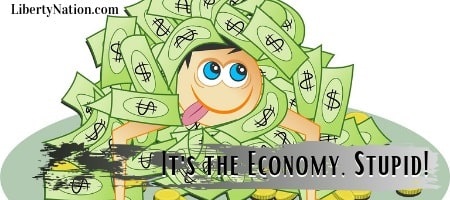The final jobs report before Election Day 2020 was out, and it was not the most glorious of monthly labor numbers for a sitting president. Would it be enough to encourage economy-focused voters to cast a ballot for President Donald Trump in November? MAGA Country may need to send some prayers to the Republican gods up in heaven.
The Labor Market Ahead of Historic Vote
 According to the Bureau of Labor Statistics (BLS), 661,000 new jobs were created in September, lowering the unemployment rate to 7.9%. The market had penciled in a gain of 850,000 new positions and a jobless rate of 8.2%. In August, the U.S. economy added 1.489 million jobs, with an unemployment rate of 8.4%.
According to the Bureau of Labor Statistics (BLS), 661,000 new jobs were created in September, lowering the unemployment rate to 7.9%. The market had penciled in a gain of 850,000 new positions and a jobless rate of 8.2%. In August, the U.S. economy added 1.489 million jobs, with an unemployment rate of 8.4%.
Last month, average hourly earnings rose 4.7% year-over-year, average weekly hours edged up 34.7, and the labor force participation rate slipped to 61.4%.
Leisure and hospitality (318,000), retail trade (142,400), professional and business services (89,000), and transportation and warehousing (73,600) led the job creation. The government shed 216,000 positions.
In total, the world’s largest economy has recovered approximately 11.4 million since May, which is still short of the 23 million lost jobs. Economists are divided over what kind of economic recovery this is: V- or K-shaped. That said, the American people seem optimistic as consumer confidence surged last month, while small businesses and manufacturing remain positive about the future.
The Dingo Ate Your Baby
Is the de-dollarization push gaining steam in our post-coronavirus global economy? The International Monetary Fund (IMF) recently published its Currency Composition of Official Foreign Exchange Reserves (COFER) report for the second quarter. The data revealed that the dollar’s share of global reserves had a tremendous first quarter, but its dominance stalled in the second quarter.
 According to the IMF, dollar-denominated exchange reserves (Treasury securities, mortgage-backed securities, and corporate bonds) held by foreign central banks rose just 1.9% to $6.901 trillion in the April-June period. In total, the greenback’s share of currency reserves dipped from 61.8% in Q1 to 61.26% in Q2. This is also down from 66% in 2014. Meanwhile, other currencies’ foreign exchange reserves increased, led by the euro, the Australian dollar, and the Canadian dollar.
According to the IMF, dollar-denominated exchange reserves (Treasury securities, mortgage-backed securities, and corporate bonds) held by foreign central banks rose just 1.9% to $6.901 trillion in the April-June period. In total, the greenback’s share of currency reserves dipped from 61.8% in Q1 to 61.26% in Q2. This is also down from 66% in 2014. Meanwhile, other currencies’ foreign exchange reserves increased, led by the euro, the Australian dollar, and the Canadian dollar.
Liberty Nation has documented the international push to veer away from the good old buck. Although the de-dollarization efforts have been led by America’s foes, particularly Russia and China, many of America’s allies appear apathetic by the latest trends. While the end to the dollar hegemony is unlikely to happen anytime soon, its reign is being threatened. It is likely only a matter of time before the dollar collapses as crushing national debt, an exploding federal deficit, and decades of failed foreign policy have weighed on the currency for too long.
What could replace the greenback? That is the $64,000 (or 63,000-euro) question. The problem is that its replacement, whether it is the yuan or the euro, will still lead to the same neo-Keynesian interventionist system of money-printing and bailouts. Gold will never be the substitute; free-market money will never be practiced by the globalist central planners.
Federal Reserve Tells Banks What To Do
The Federal Reserve announced that it would curb the big banks’ capital distributions through the end of the year, extending a move that would prevent the largest financial institutions from share buybacks and force them to cap dividends.
The restrictions apply to 34 banks with at least $100 billion in assets, including Bank of America, Citigroup, JPMorgan Chase, and Wells Fargo. The purpose of the move is to ensure these companies possess sufficient capital to survive the Coronavirus pandemic’s economic upheaval.
In June, the U.S. central bank stated that it would limit bank payouts after learning lenders endured substantial capital losses under a pandemic-focused stress test. As a result, banks would be prohibited until further notice from paying higher dividends than during the second quarter and cannot surpass their average net income from the last four quarters.
In the aftermath of the COVID-19 public health crisis, several central banks have imposed bans on banks paying dividends or buying back stock. The European Central Bank (ECB) imposed such restrictions earlier this year and extended the measure until the end of 2020. Canada, however, has refrained from instituting comparable policies as financial institutions maintain ample liquidity levels.
The big banks will undergo a second pandemic Fed stress test in the next couple of months, with an official announcement of the results by the end of the year.
~
Read more from Andrew Moran.



